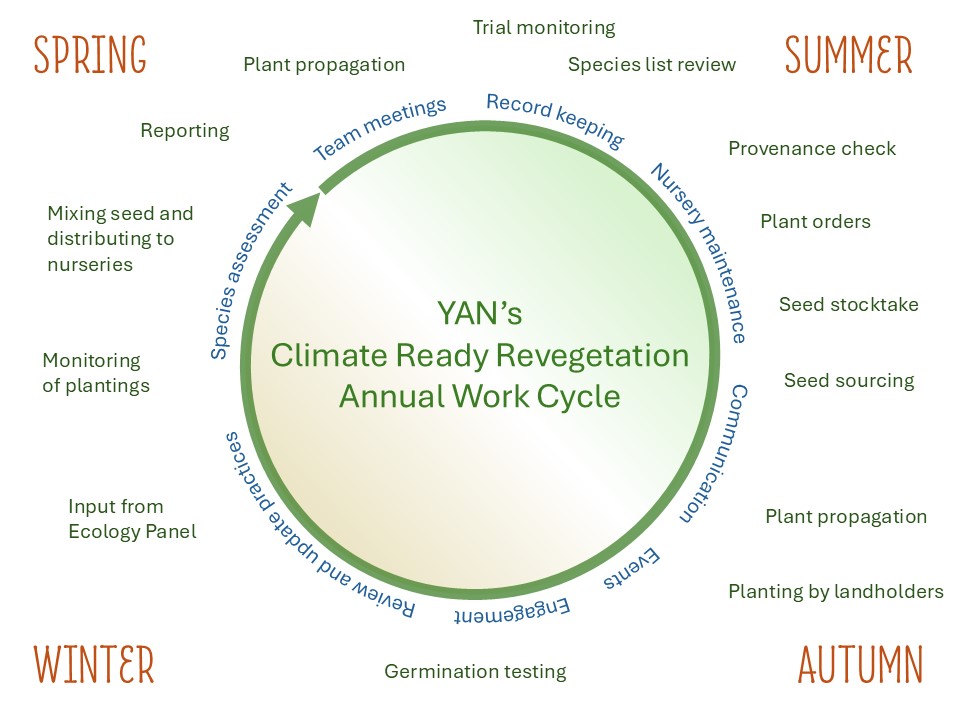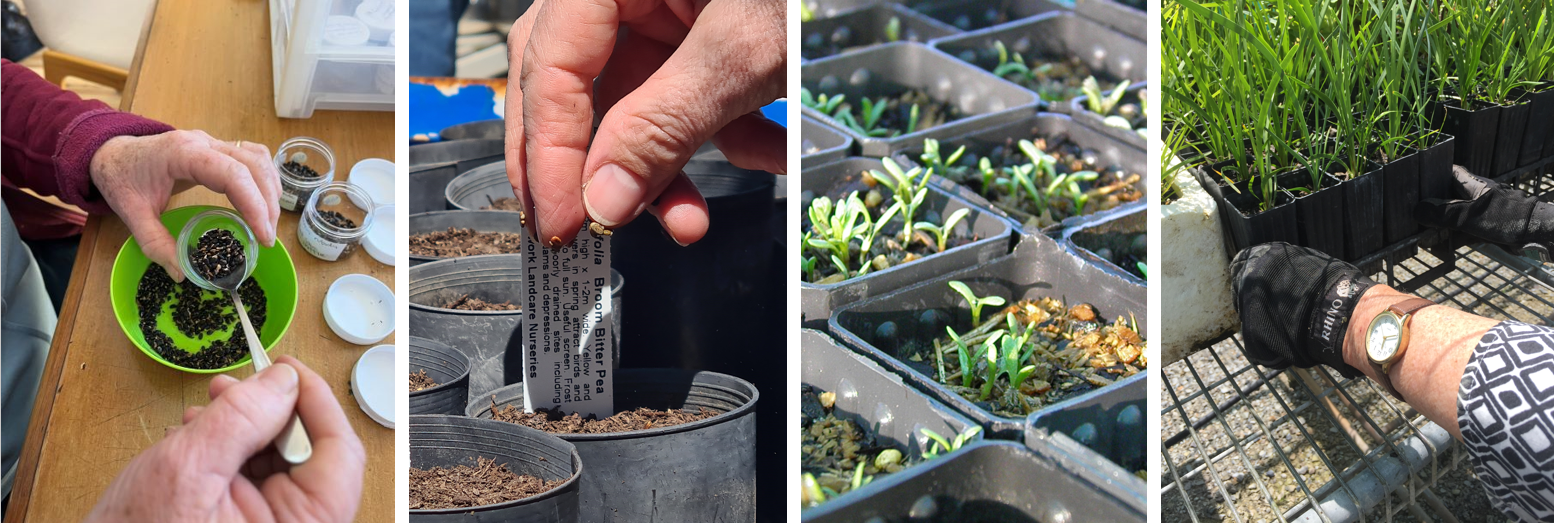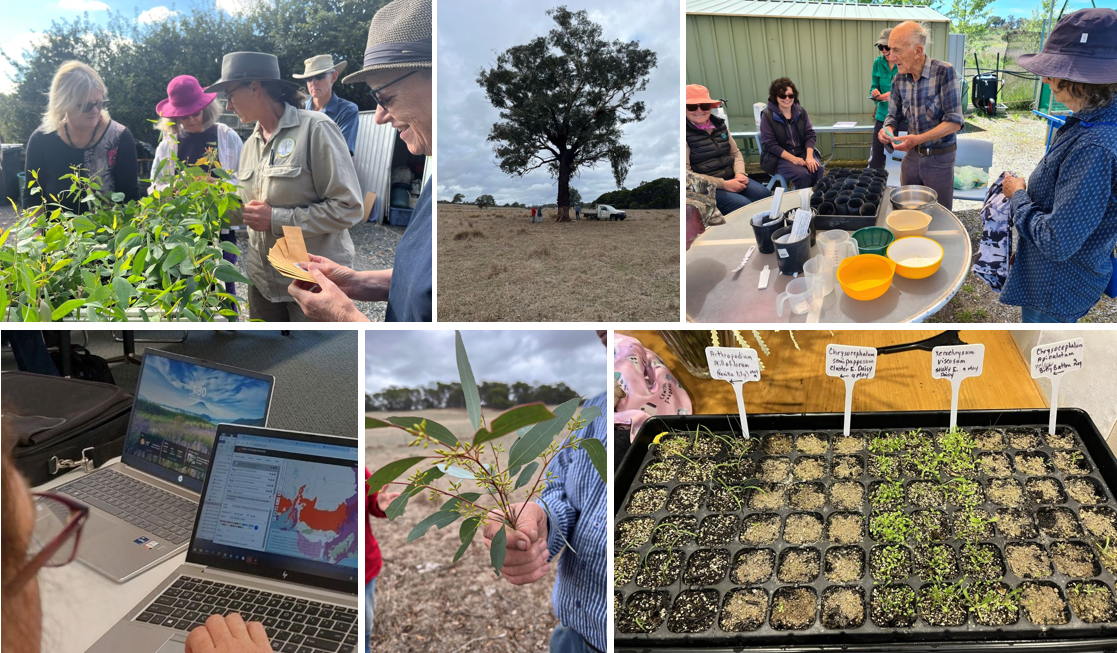Once a year, we systematically take stock of what we've accomplished in our Climate Ready Revegetation program. This annual reporting to our funders is more than just a requirement; it's a great opportunity to reflect on our successes, identify areas for refinement, and truly appreciate the enormous collective effort contributed by our dedicated volunteers as they prepare the landscape for the future.
Because we are dealing with plants, it’s not surprising that there is a seasonal flow to our work. Beginnings and ends are a bit arbitrary in natural systems, but let’s start in spring 2024 (which is when our reporting year starts).

In early spring 2024, a group of volunteers got together to sort and pot up the seed for YAN’s Climate Ready nurseries. It took several hours of focused attention, handling around 260 seed collections across our 40 climate ready nursery species. By mixing seed from multiple different provenances for each species, we are intentionally increasing the genetic diversity in our tubestock and in local revegetation plantings. This is a core strategy to improve their capacity to adapt to changing environmental conditions over time. We are incredibly grateful for the annual Michael King grants that allow us to purchase this seed.
During spring 2024, volunteers at our three Landcare nurseries, along with the nursery team at the Alexander Machonochie Centre, sowed seed for all 40 Climate Ready species.

Over spring and summer, nursery volunteers then followed up with all the essential care (watering, weeding, thinning, etc) that germinating seeds and young plants require. Altogether, across a 12-month period, around 75 volunteers contributed a total of more than 2,300 hours on these crucial nursery activities, ultimately resulting in close to 17,000 tubestock that were ready for planting.
In autumn 2025, most of the tubestock were ready to plant out. Nursery volunteers then managed the final stage, arranging the orders that landholders had placed earlier in the year and distributing the tubestock for planting.
Over autumn and early winter, some 90 landholders with their friends and family planted out the tubestock as part of large and small revegetation efforts, tree lanes, and filling-in previous plantings. We encourage all landholders to monitor their plantings and provide feedback so they can track the progress on their properties and help us to improve our practices. Meanwhile, a dedicated volunteer was conducting germination tests on newly-purchased seed collections for the following season.

During the winter months, our volunteers continued to care for the smaller number of species that are propagated in autumn, distributing any left-over plants, and preparing the nurseries for the next year’s cycle.
Also part of the annual cycle, volunteer trial hosts monitor their plantings and report on the survival of our three-species trial plantings that is checking the survival of plants grown from ‘local’ and ‘non-local’ seed. Results so far show survival is comparable between the two treatments.
Behind the Scenes
Seeds and plants are the physical, tangible, elements of our climate-ready work, but there is alsoa significant amount of strategy and coordination happening behind the scenes.
The Climate Ready Revegetation (CRR) team, which includes five long-serving volunteers as well as the CRR Project Officer and YAN Coordinator, helps to guide all aspects of the program. We had in-depth meetings roughly every three months to discuss the operation and strategic direction of the program, as well as having regular email and phone communication.

A lot of work goes into assessing species to check whether they are likely to be suitable for our future climate. In the last year, three local ecological experts also volunteered their time to advise on the ecologically important species we should consider for our nurseries.
There are also lots of other activities related to the coordination and administration of the program. This includes managing the seed pipeline (sourcing seed from numerous different provenances from multiple seed retailers, checking the spread of provenances are adequate, undertaking seed stocktakes, and keeping detailed records of our seed collections); program governance (reviewing our species list and documenting processes); outreach (encouraging landholders to monitor their plantings and communicating with our Landcare members, partners, and broader network); and the essential tasks of applying for funding and reporting to project funders.
Highlights and Future Focus
A major highlight from the past year has been our partnership with the Botanic Gardens of Sydney’s genetic team, which informs our multi-provenance seed sourcing strategy. We eagerly await the results of Eucalyptus melliodora genetic sequencing (of our seed, seedlings and plantings) to understand the genetic diversity achieved so far for this species and how to further improve it.
It has been very rewarding to launch an initiative where committed volunteers are trialling different methods at home to help us 'crack the germination code' on species difficult to propagate in our nurseries.
We have also begun seriously investigating strategies to upscale our impact, specifically by exploring climate-ready direct seeding options, networking with other groups, and actively sharing our methods and experience – including at the National Landcare Conference. To help communicate the benefits of our approach, we also engaged a filmmaker during the last year.
It’s been a massive, productive year for the program, showcasing the dedication of our entire Landcare community. If you would like to get involved with any aspect of our work, please get in touch. 🌱

By Sonya Duus, Climate Ready Revegetation Project Officer
The Climate Ready Revegetation Project has been assisted by the NSW Government through its Environmental Trust. Landcare Australia Michael King grants enable us to purchase seed from diverse provenances.
